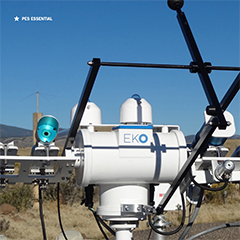Our industry continually strives to get better, smarter energy. Research and development means there are always new innovations on the market. PES brings you the latest in fast response sensors from EKO, for measuring solar radiation due to various cloud conditions. This plays an important part in the quality of converted energy from solar devices.
Even though the solar radiation incident at the top of the Earth’s atmosphere is relatively constant, the amount of solar radiation arriving at the Earth’s surface is extremely variable. It depends on the location, date and time of the day, and on the atmospheric conditions.
It is well known that absorption and scattering by gases, aerosols, and water vapour present in the atmosphere have attenuating effects on the incoming radiative power. It is also well known that the attenuation of the incoming solar radiation caused by clouds is larger than any other atmospheric component.
Another atmospheric effect has gained interest recently, while being counter intuitive – clouds can also cause enhancement of the incoming solar radiation. Partially cloudy skies with broken clouds lead to multiple scattering and radiation reflection. At times this may result in increased irradiance from a portion of the sky exceeding the expected irradiance value during actual clear sky conditions.
Furthermore, during partially cloudy-sky conditions, fast passing clouds induce irradiance variations with high frequency. During such conditions, either the sun becomes covered by clouds or it doesn’t, resulting in a short period with low irradiance followed by a short period of high irradiance, whereas the size of the irradiance step depends mostly on the season, time of the day, and cloud geometry.
These transient effects often referred to as solar radiation ramps, or power ramp rates have a big impact on the quality of the energy converted from solar devices. This effect however is very much linked to the amount of time that the device requires to react to a change in irradiance – the response time.
The impact is lower for solar thermal devices. Since these devices have a slow response time to irradiance steps, the irradiance peaks tend to be smoothed during the energy conversion.




























